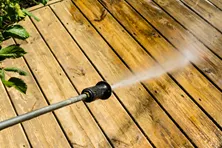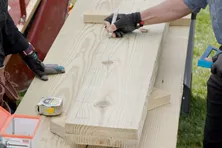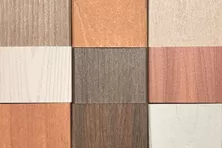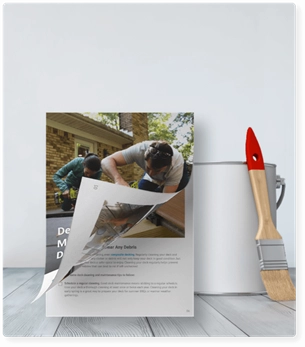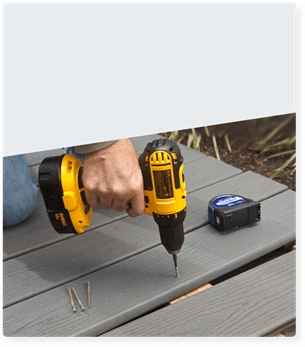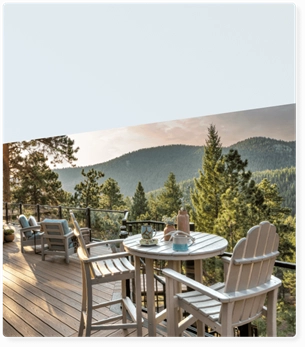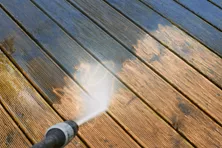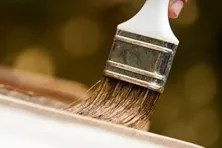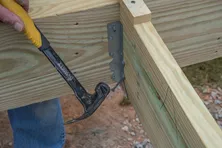As an Amazon Associate, Decks.com earns from qualifying purchases from the links in this post.
Removing Moss & Algae from Your Deck
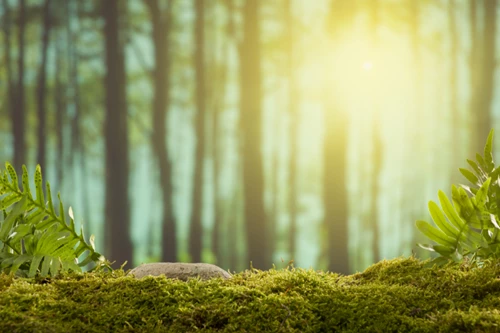
Moss and algae growth can be detrimental to the integrity of your deck if left untreated. It can also be slippery in damp conditions. And because moss and algae can spread and multiply very quickly, it’s vital to get rid of it at the first sign of growth.
The main catalyst of moss and algae growth is the accumulation of leaves and debris on your deck, which will build up and retain moisture, especially after storms and inclement weather. This trapped moisture begins to spawn mold, mildew, moss, and algae – and the damper and darker the environment – for example, if your deck has natural shade or cover from trees – the more fertile the breeding ground.
If left untreated, your deck will not only look unsightly, it could pose a slipping hazard for your family and guests. Just as bad, that retained moisture will slowly begin to penetrate into the wood, causing cracks, splinters and ultimately, wood rot. And while less prone to wood rot, composite decking isn’t immune to the hazards of moss and algae; it can be as slippery and dangerous as a wood deck if moss and algae are left unchecked.
As the saying goes, an ounce of prevention is worth a pound of cure. Don’t let debris build up on your deck in the first place. Keep it swept clean and make a point to regularly clear out any debris from cracks or gaps. Keep the surface as dry and openly exposed as possible to prevent moisture retention, bacterial growth and more.
Steps for Cleaning Moss & Algae from Your Deck
Cleaning your deck annually will help prevent moss and algae growth while increasing its longevity, in general. You can use a commercially available deck cleaner, such as #1 Deck Wood Cleaner, or you can easily create your own with a few simple household items that you probably already have.
Here’s a quick step-by-step guide for how to remove moss and green algae from a wood deck:
Step 1: Make your cleaning solution
Fill a bucket with one gallon of warm water and ¾ cup of chlorine bleach. You can also add ⅓ cup of powdered, ammonia-free laundry detergent for extra cleaning strength.
Step 2: Apply the solution
After the solution has been mixed, pour it onto your deck and allow it to sit for 10-15 minutes.
Step 3: Scrub
Next, thoroughly scrub the deck to remove all the moss and algae. We recommend using a scrub brush attached to a pole or broom handle, however, a hand brush can also be used (the latter will make for a more labor-intensive process).
Step 4: Rinse
Finally, rinse the deck surface with a garden hose to remove any lingering residue and allow the deck to dry completely.
You may also opt to use a power or pressure washer to save time and labor. It’s best to use a fanning nozzle, which will safely and effectively clean the algae and moss from your deck without damaging the wood or removing paint or stain. You can use the same detergent recipe described above, but may want to tweak proportions to ⅓ cup of powdered laundry detergent (ammonia-free), 1-quart of bleach and 3 gallons of water, depending on your washer’s capacity.
This page contains affiliate links. If you choose to purchase after clicking a link, Decks.com may receive a commission at no extra cost to you.
How to Pressure Wash a Deck
Pressure washing your deck is the best way to keep your investment looking like new. Learn how to properly clean your wood deck with these tips from Decks.com.
Deck Replacement & Repair Costs
Whether you’ve decided to tear down and rebuild your deck or if you’re only looking to repair smaller portions, you can find benchmark prices here.
Capped Composite Decking
What is capped composite decking? It's a great option if you like the look of wood but not the maintenance. Learn about capped composite at Decks.com.
UltraDeck
UltraDeck encapsulated composite decking is manufactured by Midwest Manufacturing Extrusion in Eau Claire, WI.
Common Wood Defects: Types & Causes of Lumber Issues
There are many common types of defects when it comes to wood decking, such as dead knots, shakes, twists and wanes. Learn about lumber defects at Decks.com.
More Helpful Resources
Explore Articles by Topic

Footings
Information related to installing frost footings for decks

Framing
Learn structural framing methods

Decking
Learn about wood and composite decking materials

Stairs
An in-depth look at the complex issue of how to build stairs

Railings
How to install guardrails and handrails to meet IRC code

Features
An overview on water drainage, benches, planters and lights

Design
The basics of deck design

Planning
Learn about permits and working with contractors

Porches & Patios
Build a covered deck to enjoy all seasons

Ledger
Proper attachment techniques

Care
Maintain your deck to maintain your investment

Materials
An overview on water drainage, benches, planters and lights
How to Remove Scuffs and Scratches from Composite Decking
Removing scuffs and scratches can help make your composite deck look like new. Learn how to fix and prevent your composite deck from future scratches.
How to Restore & Refinish a Deck
Decks need maintenance. A twice-yearly cleaning is needed at a minimum. But wood decks—even with good upkeep—can still warp, rot, or get termites. Plus, no stain or paint job lasts forever. Fortunately, you can reset the clock by restoring your deck and refinishing it.
Can You Paint or Stain Composite Decking?
Most composites don’t require painting or staining. However, if you are considering staining or painting your deck, you can learn how to do so and what you’ll need at Decks.com.
Is Trex Decking Worth the Investment? Expert Insights and Reviews
Discover why Trex decking is worth the investment. Learn about its durability, low maintenance, eco-friendliness, and the long-term value it adds to your home.
Different Types of Joist Hangers
You can use joist hangers to strengthen your deck. Learn more about the different types of joist hangers for you to use on your decking project at Decks.com
Fiberon
Fiberon low maintenance decking is manufactured by Fiber Composites, LLC in New London, NC
Explore Articles by Topic

Footings
Information related to installing frost footings for decks

Framing
Learn structural framing methods

Decking
Learn about wood and composite decking materials

Stairs
An in-depth look at the complex issue of how to build stairs

Railings
How to install guardrails and handrails to meet IRC code

Features
An overview on water drainage, benches, planters and lights

Design
The basics of deck design

Planning
Learn about permits and working with contractors

Porches & Patios
Build a covered deck to enjoy all seasons

Ledger
Proper attachment techniques

Care
Maintain your deck to maintain your investment

Materials
An overview on water drainage, benches, planters and lights





